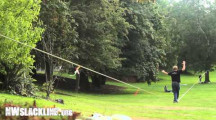I’ll add some text here in a few hours, but for now, the video is up. Sorry it took a few extra months to finish editing it because of my school schedule!
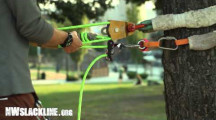
NWslackline Guide to longlining (Part 4): Tension Systems
It’s taken a few months, but this is the climax of our longline video series. Here’s where we get into all the nuts and bolts of how to actually get your line tight in a safe manner. First off, I should say, there are ways to do this that don’t involve pulleys. In the interest […]
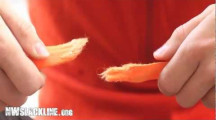
Does UV exposure affect line strength?
I definitely have left lines up for a few days before in remote spots (e.g. camping on an island), and occasionally I’ll meet someone who has a lowline or even maybe a highline that has been up for a year or more. So, a natural question to ask, is what affect might the sun (UV) […]

NWslackline guide to longlining (Part 3): Webbing
This video is a fairly short one because there’s far too much to address related to webbing to get it all into one video. Instead, I am going to cover a couple of important and mostly universal topics, and then leave the specifics (tubular, flat, nylon, polyester, etc) to a series of individual webbing review […]

Does water affect line tension?
I’ve heard conflicting theories about what water (from rain, from wet feet, etc) does to standing tension of a slackline. Mostly these theories look at nylon lines, which are hydrophilic (meaning they easily soak up water). Polyester is hydrophobic, so there is less concern there, as it’s difficult to saturate polyester with water. We know […]

HOWTO: thread a slackline
Threaded line is one of the most old-school slackline concepts for making stronger lines. The jury, however, is still out on whether it actually makes your line much stronger (or, at minimum, the relationship between the two lines and the overall strength). The basic premise is that a tubular line is hollow, and thus we […]
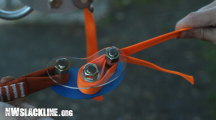
NWslackline guide to longlining (Part 2): Webbing Attachment
Knots and line lockers You have to attach the line to the anchor sling (and your tightening system) somehow. Since the beginning, slackliners were tying knots and using hitches to rig their lines. Sometime in the early-to-mid 2000s, the use of a chain-link line locker became popular. These reduce the ‘folds’ in the webbing, allowing […]
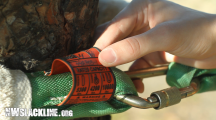
NWslackline guide to longlining (Part 1): Anchor Slings
This will be the easiest topic for us to cover, because there really isn’t that much to talk about. We need to discuss the different types of anchor slings, and the different ways you can rig them. In a broad sense, the two types of slings are “homemade” and “manufactured”. Homemade slings are anything you […]
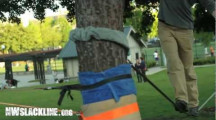
The ultimate in slackline tree padding
I’m always improving little aspects of my slackline setup, and in early 2010 I realized that the towel strips I was using would be way better if they were tubes instead of strips. I started using duct tape to make them into tubes, and then eventually began to sew them. The strips fray and give […]
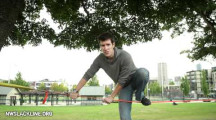
How to Chongo mount a slackline
Chongo mount is a technique employed to get up on the line from the side, primarily used in remounting highlines after a fall, or for any other line from the mantle position (for instance, a 7- or 8-foot-high slackline). I taught myself to Chongo before I knew what it was, and without any real guidance. […]
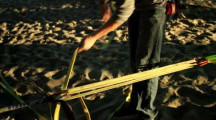
Rigging a 2″ line without a ratchet.
I’ve had a couple of requests for a “howto” on rigging a two-inch line, sans ratchet, so here it is. Basically we’re just line-locking in a short piece of one-inch webbing (usually about 10ft will do it) and then making a primitive system with it. So if you already know how to do a primitive, […]
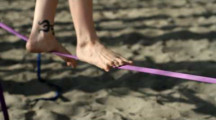
How to turn on a slackline
At Mary Helen’s suggestion we made a quick tutorial showing a few different turning styles (and with commentary from the respective slackliners). I hope this helps newer slackers get a better idea of the various ways to approach turns.

Triangle and n-way slacklines
I got an e-mail from a reader asking if we could do a tutorial on multi-directional lines (triangles, pentagons, etc). Luckily today was our mid-May meetup, so I whipped up a 3-way line and brought the camera. Here’s a quick video howto and some shots of the line in action.
Primitive tension testing results.
Recently I saw someone rigging a “primitive” slackline with five carabiners (one on the static end, and four for the tension system). The “elegant friction lock” method I use was also not being employed. Basically this is as far as you can get from how I setup my primitive systems and still be considered the […]
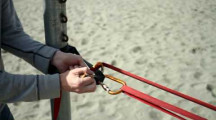
Rigging a primitive slackline
So I finally got around to editing a video on how to rig a primitive line. If you’d like the pictorial version of this, see [here]. Some other useful posts (with skills utilized in this video) include [using a line locker] and [making anchor slings]. If you want to know how to get the line […]
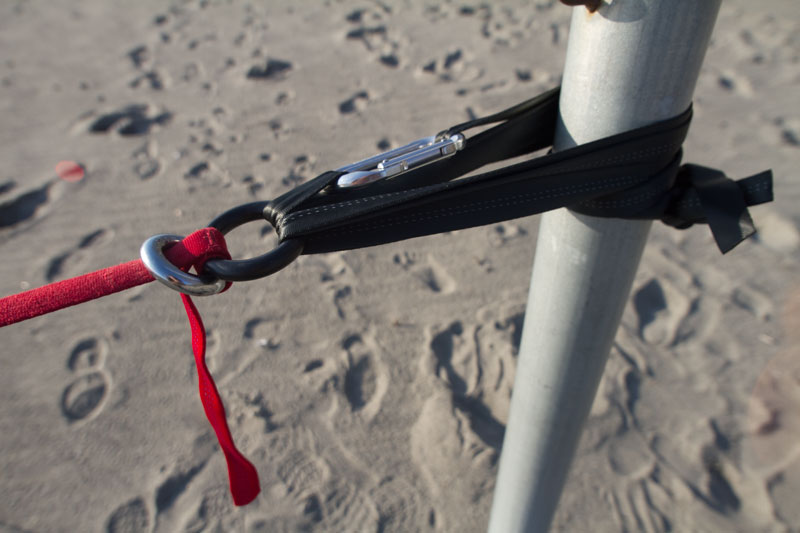
Elegance, rappel ring be thy name
So I was sitting on the couch tonight while it’s raining outside, decompressing after several long weeks of school and work, and I started wondering if I could rig a slackline without any carabiners at all. So now I have a new “elegant ring method.” [ angle #2 | angle #3 ] Of course I […]

Making anchor slings
Have you seen me mentioning making slings with your own webbing by tying a “water knot?” Confused as to what the heck a water knot is, or how to use it to make a sling? Well, here’s a video that shows you how to do just that.
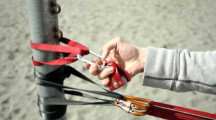
Strength of 3 men, for only $20
All of you should be familiar with the basic “Ellington” or “primitive” system. It uses 4 carabiners: 1 to hold the end of the line to one anchor; 1 hitched or line-locked about 80% of the distance from that anchor; 2 more at the other anchor, and a very ‘primitive’ looping of the remaining 20% […]
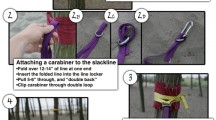
Setting up a basic (“primitive”) slackline
(NOTE* This now exists as a video too) WHAT: Rigging a 3:1 primitive slackline. WHY: Because ratchets are lame, and this setup is cleaner, lighter, and fun. HOW: This assumes you already have all the gear needed for a primitive setup. If you need to build a primitive setup, see: this link. We’re going to […]

Triloading 101
It’s important to understand the strength ratings of your various equipment. Carabiners are rated for a couple of different types of loading, and without exception the pull-load (coincident with the spine of the carabiner) is the highest rating. Loads in other directions (pulling on the gate, for instance) are usually substantially lower. Simply put, this […]

Article: Using line lockers
Normally you will require a couple of knots in a slackline in order to rig it properly. Each end of the line must attach to your anchor slings somehow, and often a clove hitch is used to attach it to a carabiner (which is then clipped to the sling). Some of the “kit” lines have […]

